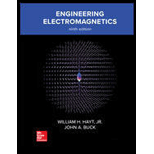
Concept explainers
For the parallel-plate capacitor shown in Figure 6. 3, find the potential field in the interior if the upper plate (at z = d) is raised to potential V0, while the lower plate (at z = 0) is grounded. Do this by solving Laplace' s equation separately in each of the two dielectrics. These solutions, as well as the electric flux density, must be continuous across the dielectric interface. Take the interface to he at z = b.
The potential field between plates
Answer to Problem 6.31P
The values are
Explanation of Solution
Calculation:
The Poisson's equation is defined for
The Poisson's equation (generalization of Laplace equation) is written as
Here,
Integrate the equation (1) with respect to
The Poisson's equation is defined for the region
The Poisson's equation is written as
Integrate the equation (3) with respect to
Substitute
Simplified the equation (5) as
Equation (4) is multiplied with
If equation (6) and equation (7) is equal, then it is written as
Simplified the equation (8) as
Substitute
Integrate the equation (2) with respect to
Integrate the equation (9) with respect to
Substitute
Equation (12) is simplified as
Substitute
Substitute
If equation (13) and equation (14) is equal, then it is written as
Substitute
Substitute
Substitute
The potential difference
Substitute
Substitute
Conclusion:
Therefore, the final voltage
Want to see more full solutions like this?
Chapter 6 Solutions
Engineering Electromagnetics
- Both the Biot-Savart and Coulomb's laws exhibit an inverse-square relationship between field and source.? True O Falsearrow_forwardThe parallel-plate capacitor shown to the right is discharging so that the electric field between the plates decreases. Answer the questions below and explain your reasoning. The bulk of the credit will come from your explanation. What is the direction of the magnetic field at point P?arrow_forwardQ5. Consider two magnetic fields given by (a)B = 3x²y – 4xz + 5z2 and (b) B =constant. Comment on these magnetic fields.arrow_forward
- The width of the plates of the capacitor in the figure is “a”. Bottom plate + Q = 480ε0 upper plate with Q = -480ε0 Accordingly: a) the capacitance of this capacitor b) the voltage between its ends c) polarization vector d) Find the polarized charge density on the surfaces e) Find the starting current and resistance before loading.arrow_forwardFigure shows a circuit and a conducting rod. A conducting rod moves with a constant velocity vperpendicular to a circuit with a current I=2.82sin(??)arrow_forwardQ14. An air filled parallel plate capacitor is arranged such that the upper plate carries surface charge density 2C/m² and lower plate carries surface charge density -2C/m² as shown in figure. The electric field intensity under the bottom plate will bearrow_forward
- What is a dielectric material, and what does it do? a. What are 3 ways capacitance can be increased by changing the materials?arrow_forwardA cylindrical long solenoid of length 2000 mm has 20 mm diameter. If number of turns wounded on solenoid is 2000 turns what is value of inductance.arrow_forwardFind the inductance per unit length of a very long solenoid with a unit length of N windings. The permeability of the core is μ.arrow_forward
- 6- Why an insulator is represented as a capacitor C? What are the assumption modes?arrow_forwardFor the circuit shown in Figure:a. Determine the reluctance values and show themagnetic circuit, assuming that μ = 3,000μ0.b. Determine the inductance of the device.c. The inductance of the device can be modified bycutting an air gap in the magnetic structure. If a gapof 0.1 mm is cut in the arm of length l3, what is thenew value of inductance?d. As the gap is increased in size (length), what is thelimiting value of inductance? Neglect leakage fluxand fringing effects.arrow_forwardin a circuit, inductors are connected parallel with inductances of La, Lb, Lc. assume that magnetic interaction is present, determine the inductance of a single inductor that could replace the 3 inductors.arrow_forward
 Introductory Circuit Analysis (13th Edition)Electrical EngineeringISBN:9780133923605Author:Robert L. BoylestadPublisher:PEARSON
Introductory Circuit Analysis (13th Edition)Electrical EngineeringISBN:9780133923605Author:Robert L. BoylestadPublisher:PEARSON Delmar's Standard Textbook Of ElectricityElectrical EngineeringISBN:9781337900348Author:Stephen L. HermanPublisher:Cengage Learning
Delmar's Standard Textbook Of ElectricityElectrical EngineeringISBN:9781337900348Author:Stephen L. HermanPublisher:Cengage Learning Programmable Logic ControllersElectrical EngineeringISBN:9780073373843Author:Frank D. PetruzellaPublisher:McGraw-Hill Education
Programmable Logic ControllersElectrical EngineeringISBN:9780073373843Author:Frank D. PetruzellaPublisher:McGraw-Hill Education Fundamentals of Electric CircuitsElectrical EngineeringISBN:9780078028229Author:Charles K Alexander, Matthew SadikuPublisher:McGraw-Hill Education
Fundamentals of Electric CircuitsElectrical EngineeringISBN:9780078028229Author:Charles K Alexander, Matthew SadikuPublisher:McGraw-Hill Education Electric Circuits. (11th Edition)Electrical EngineeringISBN:9780134746968Author:James W. Nilsson, Susan RiedelPublisher:PEARSON
Electric Circuits. (11th Edition)Electrical EngineeringISBN:9780134746968Author:James W. Nilsson, Susan RiedelPublisher:PEARSON Engineering ElectromagneticsElectrical EngineeringISBN:9780078028151Author:Hayt, William H. (william Hart), Jr, BUCK, John A.Publisher:Mcgraw-hill Education,
Engineering ElectromagneticsElectrical EngineeringISBN:9780078028151Author:Hayt, William H. (william Hart), Jr, BUCK, John A.Publisher:Mcgraw-hill Education,





